Tips On How To View The Total Solar Eclipse Safely
3rd Apr 2024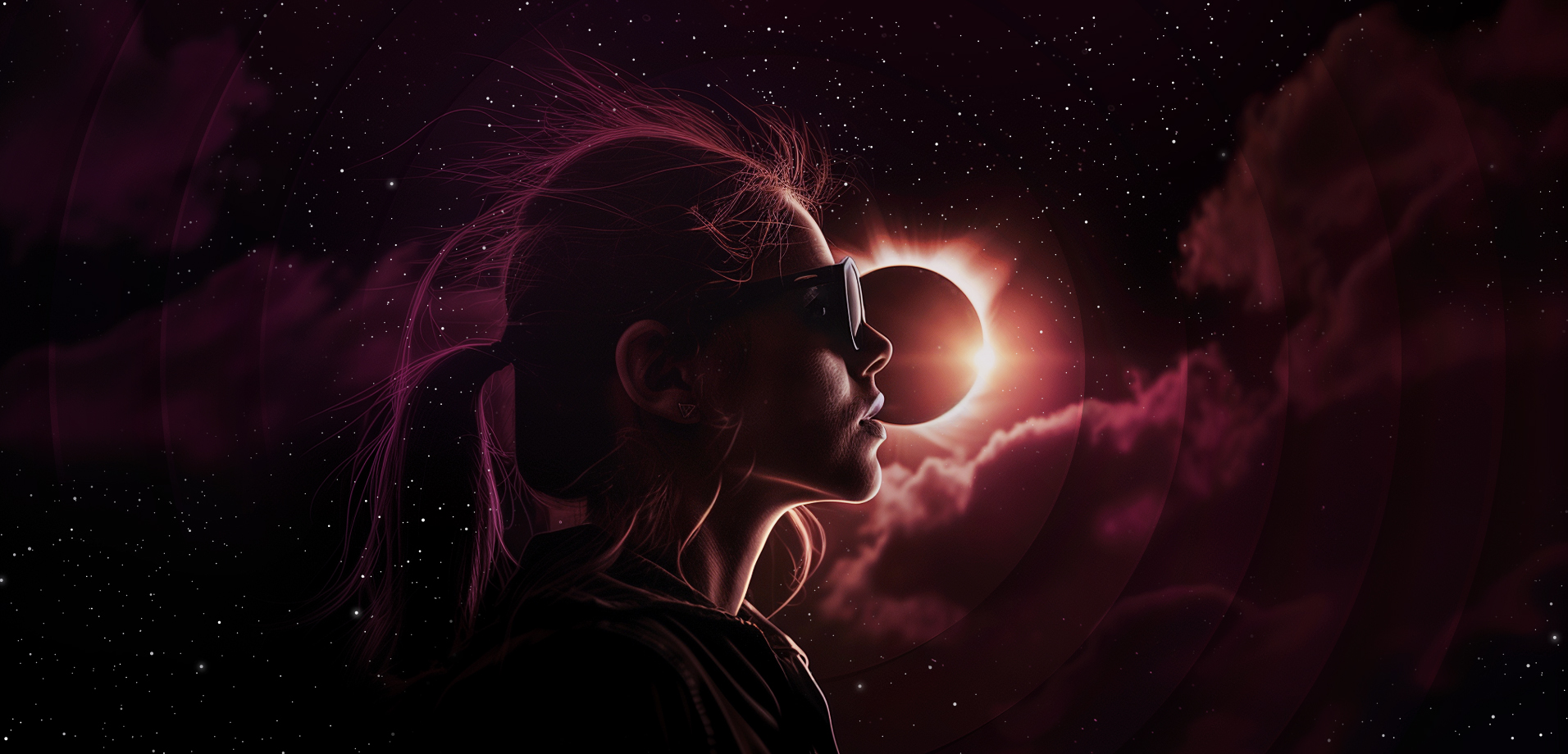
On 8 April, we are expecting one of the rarest natural phenomena that you can see with your own eyes – the total solar eclipse. However, witnessing this celestial event requires caution, as directly viewing it can be harmful to your vision.
We prepared a set of tips on how to observe the total solar eclipse safely. Whether you have solar viewing glasses or not, plan to enjoy the total solar eclipse at home or at a special location. Check these tips to get the best experience without damaging your eyes.
Tips On How To Look At A Solar Eclipse Safely
During a total solar eclipse, the moon entirely covers the sun, temporarily darkening the sky. Directly gazing at the sun during this phenomenon can lead to retinal damage due to the intense levels of ultraviolet (UV) light. To view the eclipse safely, Dr. Dawn Davis, a dermatologist at Mayo Clinic, recommends using special solar filters for your eyes and SPF products to protect your skin from the sun’s rays if you are outside for a while.
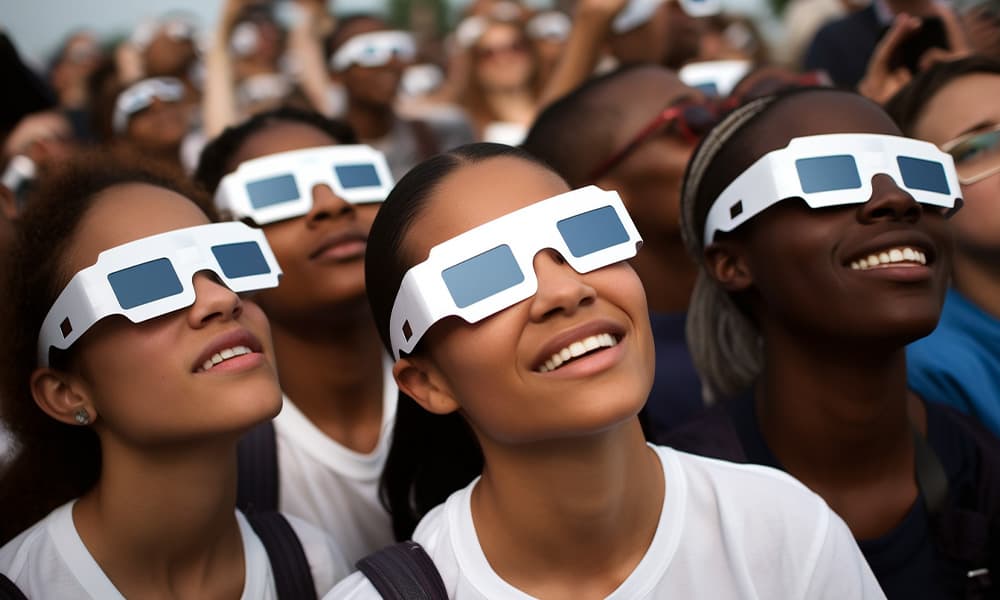
To sum up, here are the basic tips on how to view the total solar eclipse safely:
- Plan the location ahead to avoid last-minute trips and traffic jams.
- Don’t try to watch the solar eclipse while driving, riding a bike or on the go. This may lead to car accidents or dangerous situations.
- Use certified solar viewing glasses.
- Alternatively, buy or create a Pinhole projector.
- Consider wearing a broad-brimmed hat that covers your face and neck and protective clothing that covers your arms and legs.
- Choose light-coloured, loose-fitting and breathable fabrics that can keep you cool.
- Use sunscreen products with SPF 50.
- To stay hydrated, drink plenty of water.
- Also, stay in the shade during the peak hours of the sun’s intensity (between 10 a.m. and 4 p.m.) to avoid heat exhaustion.
“I would reapply every two hours at minimum. And if you happen to sweat or get wet, I would reapply immediately,” Dr. Davis adds.
When you’ve made sure you’ve followed the previous points, it’s time to choose a piece of equipment (or a technique) to enjoy the total solar eclipse safely and without harming your eyes.
Solar Viewing Glasses To View The Total Solar Eclipse Safely
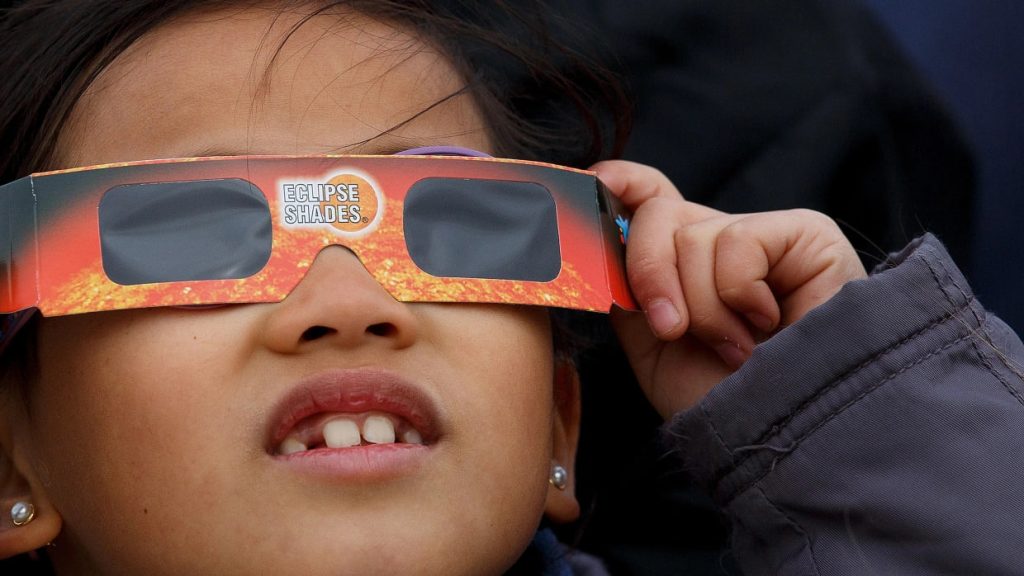
Solar viewing glasses, also known as eclipse glasses, are the easiest and most cost-effective way to safely observe a solar eclipse.
These glasses consist of special-purpose solar filters that are specifically designed to block out harmful ultraviolet (UV) rays, infrared radiation, and intense visible sunlight. These filters are usually made from a material called “solar film” or “solar foil”, which is coated between two layers of thin, durable cardboard or plastic.
The solar film allows only a tiny fraction of the Sun’s light to pass through, reducing its brightness to a level that is safe for our eyes.
But be attentive and buy only certified solar viewing glasses, as it is crucial for your safety! Check out whether the vendor you purchased your glasses from is on the list of verified North American manufacturers by the American Astronomical Society.
Free Eclipse Glasses for Libraries
If you don’t want to buy your own glasses, you can use the initiative from The STAR Library Network. It has distributed 5 million solar eclipse glasses to 10,000 public libraries across the USA. To find a location near you, check the provided link for library locations.
How To Watch A Solar Eclipse Safely Without Glasses
In addition to special glasses, there are alternative safe methods for viewing the sun. One of them is a pinhole projector. You can buy it or make it yourself. The commercial version of a pinhole protector is called the Folded-Keplerian telescope, which is easy to use and suitable even for kids.
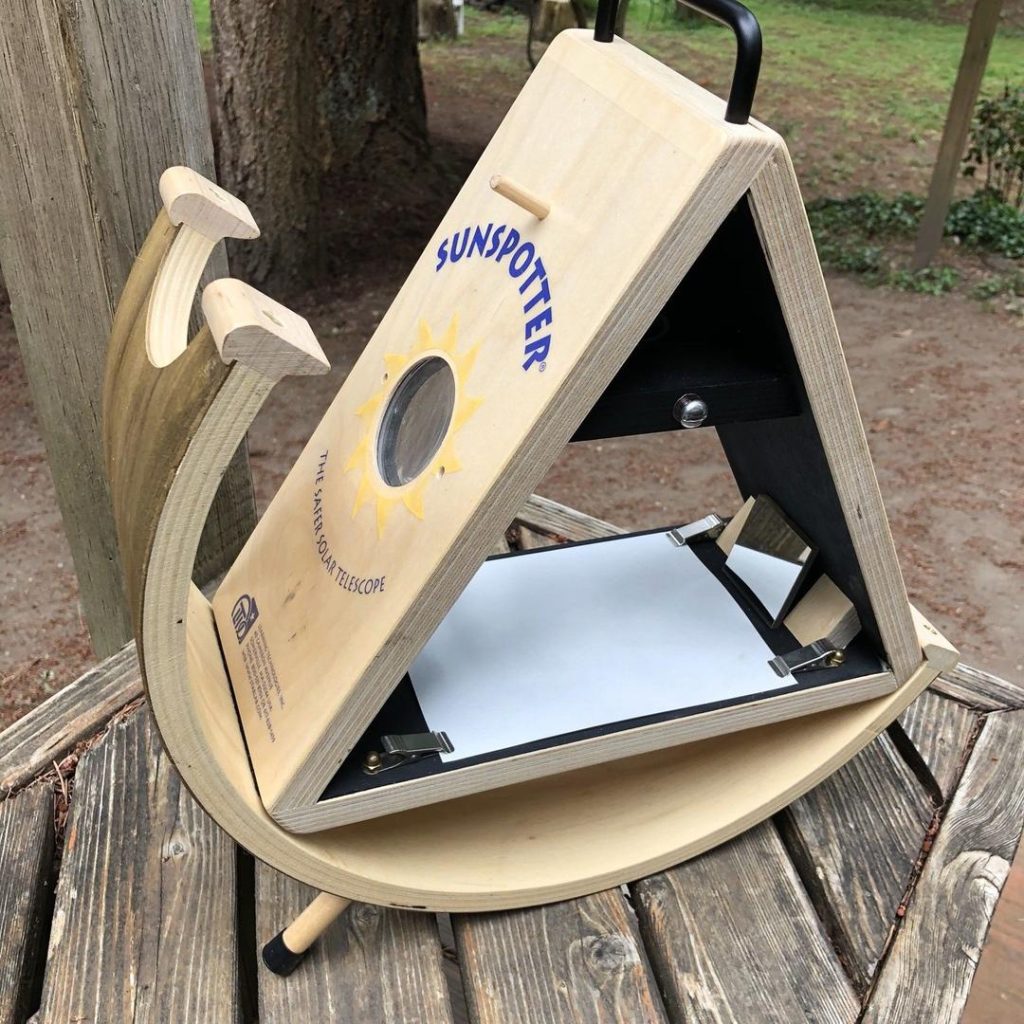
DIY Pinhole Projector
To create a DIY pinhole projector, you need a long box (at least six feet in length), a piece of aluminum foil, a pin, and a sheet of white paper. The length of the box plays a crucial role: the longer the box, the larger the projected image of the sun will be. To estimate the size of the image, multiply the length of the box by 0.01. For example, if your box measures six feet (72 inches) in length, the diameter of your solar image will be approximately 0.72 inches or about ¾ inch.
Here’s a step-by-step guide on how to create a DIY pinhole projector:
- Find or create a long box or tube. If you don’t have a single long tube, you can tape together two or more shorter ones. Two triangular shipping tubes taped together make an effective solar viewer. Remove the cardboard from one end of each tube and securely tape those ends together with duct tape to allow light to travel the length of the tube.
- Cut a one-inch hole in the centre of one end of the box. Cover the hole with a piece of foil and poke a small hole in it with a pin. .
- On the opposite end of the tube, cut a substantial viewing hole in the side of the box. Place a piece of white paper at the end of the box, directly inside the viewing hole. This paper will serve as the screen where the projected image of the Sun will appear.

To use your viewer, aim the pinhole end of the box directly at the Sun. Adjust the position until you see a circular spot of light on the paper at the other end: this is your pinhole image of the Sun! If you have difficulty aiming the viewer, observe the shadow cast by the box on the ground. Move the viewer until the shadow which becomes minimal, resembling the end of the box with no visible side shadows. Important: avoid looking directly through the pinhole at the Sun. Instead, focus only on the image projected onto the paper!
Quick And Easy Viewing Techniques

If you lack time to make a pinhole projector, here are some even easier ways to watch the eclipse:
- Create a simple solar viewer using two pieces of cardboard. Begin by cutting a one-inch hole in one piece of cardboard, then cover it with foil and make a pinhole in the centre of the foil. Use the other piece of cardboard, preferably white, as a screen. With the Sun behind you, hold the pinhole cardboard as far from the screen as possible: the farther apart they are, the larger your image will be.
- Alternatively, use your hands by holding them with fingers overlapping at right angles to form pinholes, which will project images of the Sun onto the ground.
- If you’re near shade trees, try observing the Sun’s images through the holes formed by the leaves. You can also use a piece of white cardboard to capture these images for a unique viewing experience.
- Another option is to use a colander, holding it about 20 inches above the ground. The many holes in the colander will create multiple images of the Sun. For a clearer view, cast these images onto a white piece of paper or sheet.
Optical Projection
Pinhole images have a significant drawback: they are pretty small. You can magnify the image of the Sun using a pair of binoculars through optical projection:
- Attach the binoculars to a tripod with the eyepieces facing downward. You can use duct tape for this purpose.
- Create a Sun shield from a piece of cardboard, cutting a hole for one of the binocular lenses. Tape the shield to the front of the binoculars, ensuring the lens protrudes through the hole. Seal any light leaks around the shield with duct tape.
- Direct the binoculars toward the Sun while holding a piece of white cardboard about one foot beyond the binoculars.
- It may take some effort to locate the Sun, but once you do, you can focus the binoculars to produce a sharp image of the Sun. Remember to periodically adjust the tripod to account for the Earth’s rotation.
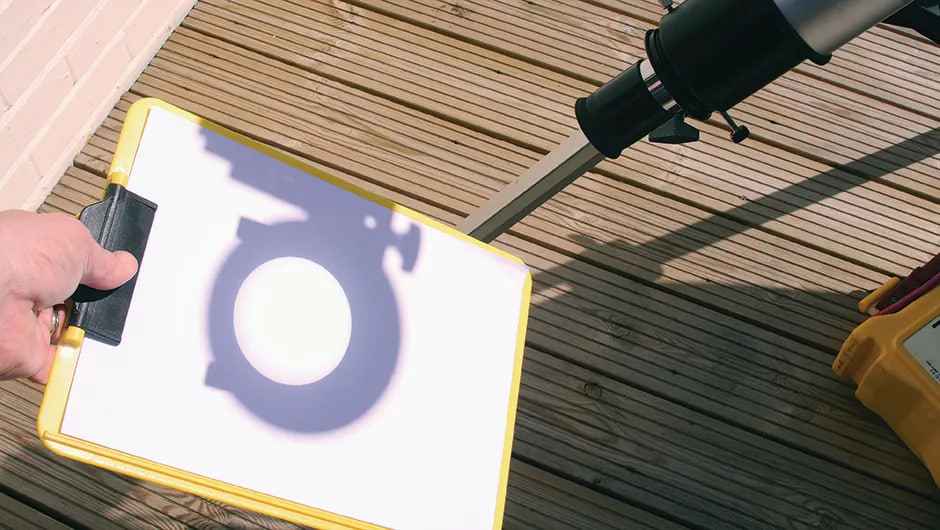
Ensure that you avoid putting your hand or any flammable objects near the eyepiece, as the concentrated sunlight exiting there can cause burns.
Use Filters To View The Total Solar Eclipse Safely
If you cannot resist looking directly at the Sun, ensure that you possess the correct filter – a professionally crafted white light filter that effectively blocks 99.999 per cent of sunlight. Alternatively, you can view the Sun using a number 14 welder’s glass, which can be obtained from welding supply stores.
A Telescope To View The Total Solar Eclipse Safely
If you intend to use a filter with a telescope, only use the filter provided by the manufacturer or one specifically designed for the instrument you’re using. However, avoid using filters that attach to the eyepiece, especially those provided by some inexpensive telescope manufacturers. These filters, typically welder’s glass, may overheat and crack while you’re observing through the telescope. A proper solar filter should always be placed at the front end of the telescope to block sunlight before it enters the optical system.
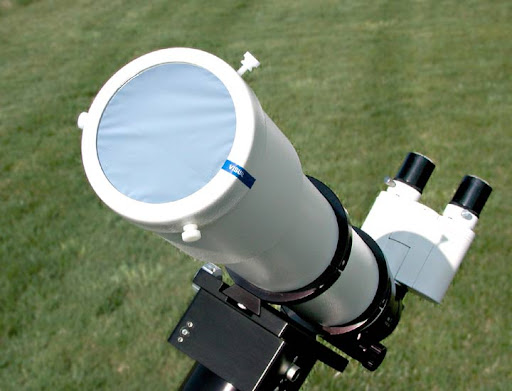
Also, ensure your telescope and solar filter are in good condition before observing. Inspect them for any signs of damage and replace them if necessary.
Binoculars With Filters
Another piece of equipment for safely observing the eclipse is to use binoculars equipped with filters. One advantage of such binoculars is their ability to provide a magnified view of the Sun while still offering protection from harmful solar radiation. Additionally, they are portable and easy to use.

Handheld Solar Viewers
As an alternative to eclipse glasses, telescopes, and binoculars, you can use a handheld solar viewer. They are small, portable devices specifically designed for safely observing the eclipse. They consist of specialised filters that block harmful solar radiation. When using a handheld solar viewer, ensure that it is certified to meet international safety standards for solar observation and follow all instructions provided by the manufacturer to prevent eye damage.
Smartphone Apps To Watch Solar Eclipse
There are also several apps for smartphones that provide tools for watching and photographing solar eclipses safely and enjoyably. Everything you need is your phone camera. Here is a list of them:
- Solar Snap Eclipse App Kit – has everything you need to easily photograph an eclipse.
- SafeShot – eye safe viewing window means you don’t need eclipse glasses if you’re using this app. Plus, SafeShot will protect your entire face as well.
- VisiSolar – protects your smartphone camera from harmful rays.
Do NOT Use These Techniques To Safely Watch Socal Eclipse
At first glance, these tools may seem like a good idea for observing a solar eclipse, but they are not:
- Sunglasses – they do not provide adequate protection against the intense sunlight during an eclipse.
- Polaroid filters – they do not offer sufficient protection for your vision.
- Smoked glass – while it may dim the sun, it still does not block enough harmful sunlight.
- Exposed colour film – it does not provide any protection and may damage your eyes.
- X-ray film – it is not designed for viewing the eclipse and may cause damage of your eyes..
- Photographic neutral-density filters: they are also not intended for solar viewing.
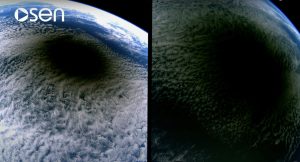





Thank you for your comment! It will be visible on the site after moderation.